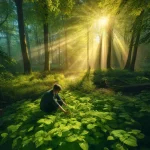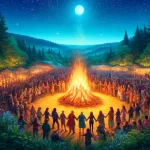
Approx. Reading time: About 11 Minutes

Introduction
Exploring the Tapestry of Witchcraft, Wicca, and Paganism
Unraveling the Threads of Mystical Practices
In the enchanting realms of magic and mysticism, terms like “witch,” “Wiccan,” and “Pagan” are often used interchangeably, leading to confusion among those traversing the diverse landscapes of the occult. Let’s embark on a journey to unravel the distinct threads that weave together these fascinating practices, shedding light on the rich tapestry of witchcraft, Wicca, and Paganism.

Witchcraft, the Ancient Dance with Energy
The Art of the Craft Witchcraft, often considered the oldest spiritual practice, is a magical art rooted in the manipulation of energy to bring about change. Witches harness the natural forces of the universe to manifest their intentions, utilizing spells, rituals, and the power of the elements. While witchcraft itself is a broad term encompassing various traditions and belief systems, it serves as the umbrella under which both Wicca and Paganism find their place.
At the very core of the mystical realms, witchcraft stands as a timeless practice, often regarded as the oldest spiritual art known to humanity. It is a captivating dance with energy, a profound connection with the natural forces that weave through the fabric of existence. Rooted in ancient wisdom, witchcraft is an art that spans cultures, continents, and centuries, providing a conduit for individuals to commune with the unseen energies that shape reality.
The essence of witchcraft lies in the manipulation of energy, an ethereal force that flows through everything in the universe. Witches, as practitioners of this ancient craft, understand the delicate interplay between intention and energy. They become weavers, shaping the threads of reality through the careful manipulation of these mystical energies.
In the practice of witchcraft, spells become the language through which intentions are articulated. These incantations, often spoken with reverence and purpose, serve as the keys to unlock the doors between the mundane and the magical. Witches infuse their spells with intention, directing the energy towards their desires, whether for healing, protection, or manifestation.
Rituals form an integral part of the witch’s journey, creating sacred spaces where the veil between worlds thins, allowing a harmonious exchange of energies. Circles, often cast with precision and intention, become arenas where the witch can commune with the divine, the elemental, and the spiritual. The power of the elements—earth, air, fire, and water—becomes a tool in the hands of the adept, amplifying the potency of their magical workings.
Witchcraft, as a term, serves as a vast umbrella encompassing a myriad of traditions, each with its own unique practices, symbols, and rituals. From the cunning folk of Europe to the wise women of ancient civilizations, the diverse expressions of witchcraft reveal the adaptability and resilience of this mystical art. It is within this expansive realm that both Wicca and Paganism find their niche, drawing inspiration from the ancient roots of witchcraft while evolving into distinct paths of their own.
As contemporary witches navigate the intricate tapestry of magic, they stand on the shoulders of their mystical ancestors, inheritors of a legacy that transcends time and space. Witchcraft, with its rich history and ever-evolving practices, remains a beacon for those who seek to explore the depths of the unseen, to dance with the energies that flow through the veins of the universe, and to wield the ancient art of the craft.
Wicca – The Tapestry of Modern Paganism
A Modern Pagan Path Wicca, a modern Pagan religion, emerged in the mid-20th century, largely popularized by figures like Gerald Gardner and Doreen Valiente. Wiccans follow a structured system of beliefs and practices, often centered around the worship of a dual deity—The God and The Goddess. Rituals, Sabbats, and Esbats mark the Wiccan calendar, emphasizing the cycles of nature and the harmonious balance of polarities. Wiccans hold the Wiccan Rede (“An’ it harm none, do what ye will”) as a guiding ethical principle, promoting a responsible and positive use of magic.
In the mid-20th century, against the backdrop of societal shifts and a rekindled interest in the mystical, Wicca emerged as a modern Pagan religion, forever altering the landscape of contemporary spirituality. The architects of this transformative movement, figures like Gerald Gardner and Doreen Valiente, wove together threads of ancient wisdom, folklore, and ceremonial magic to craft a spiritual path that resonates with seekers around the world.
At its heart, Wicca embraces the label of a modern Pagan religion, acknowledging its roots in ancient practices while adapting to the needs of the contemporary seeker. Wiccans find inspiration in the cyclical rhythms of nature, aligning their beliefs and practices with the ever-turning wheel of the seasons. The worship of a dual deity—the God and the Goddess—takes center stage in Wiccan cosmology, symbolizing the divine polarity inherent in the natural world.
Rituals form the cornerstone of Wiccan practice, serving as conduits for spiritual connection and transformation. The Wiccan calendar is marked by Sabbats and Esbats, sacred moments that align with the cycles of the moon and the changing seasons. Sabbats celebrate the major turning points of the solar year, such as the equinoxes and solstices, while Esbats are lunar rituals that honor the phases of the moon, emphasizing the ebb and flow of magical energies.
Central to the Wiccan ethos is the Wiccan Rede, a succinct ethical principle that guides practitioners in their magical endeavors: “An’ it harm none, do what ye will.” This guiding light underscores the responsibility and accountability inherent in wielding magical forces. Wiccans strive for a harmonious balance in their actions, ensuring that their use of magic is aligned with benevolence and respect for all living things.
The harmonious interplay of polarities is a recurring theme in Wicca, reflecting the understanding that life is a delicate dance between light and dark, masculine, and feminine, creation and destruction. Wiccan rituals often embody this duality, seeking to find equilibrium and unity amid these cosmic forces.
As Wicca continues to evolve and adapt to the ever-changing tapestry of spiritual exploration, it remains a beacon for those who seek a structured yet flexible path, one that honors the ancient roots of Paganism while embracing the unique journey of each practitioner. In the sacred circle of Wicca, modern seekers find a space where the divine is celebrated, magic is woven, and the dance of life unfolds in harmony with the rhythms of the natural world.
Paganism – The Eclectic Symphony of Nature’s Spirituality
Embracing the Divine in Nature Paganism, a diverse umbrella term encompassing a multitude of spiritual practices, celebrates a connection with nature and the divine forces within it. Pagans may follow various pantheons, honoring gods and goddesses associated with natural elements, seasons, and aspects of life. Unlike Wicca, Paganism lacks a centralized dogma, allowing practitioners to explore a wide range of beliefs and practices. The reverence for the Earth, cycles of nature, and a deep connection to the spiritual realm are common threads among Pagans.
Within the vast and varied landscape of spiritual exploration, Paganism stands as an eclectic symphony, weaving together the diverse threads of ancient wisdom, cultural traditions, and a profound reverence for the natural world. As an umbrella term encompassing a multitude of spiritual practices, Paganism invites practitioners to embark on a deeply personal journey, celebrating the sacred tapestry of life and embracing the divine forces that resonate within the realms of nature.
Central to Paganism is the celebration of a connection with nature that goes beyond mere admiration—it is a sacred communion. Pagans find spiritual significance in the rustle of leaves, the flowing waters, the vibrant blooms, and the changing seasons. The Earth, in all its majesty, is not merely a backdrop but a living, breathing manifestation of the divine. Pagan rituals often take place outdoors, under the open sky or within the embrace of ancient groves, fostering a direct and tangible link to the natural forces that permeate existence.
Unlike more structured paths like Wicca, Paganism lacks a centralized dogma or set of prescribed beliefs. This absence of rigid doctrine provides Pagans with the freedom to explore and define their spirituality based on personal experiences, cultural influences, and individual interpretations. This diversity within Paganism results in a rich tapestry of beliefs, rituals, and practices, as practitioners may choose to follow various pantheons, honor specific deities associated with natural elements, or forge their own unique path.
Within the realm of Paganism, gods and goddesses are revered as embodiments of the natural world’s energies. Pantheons from different cultures, whether Greek, Norse, Celtic, or others, offer a myriad of divine archetypes representing the forces of creation, fertility, wisdom, and more. Pagans may choose to work with specific deities that resonate with their spiritual journey, forging personal relationships through rituals, offerings, and meditative practices.
A unifying thread among Pagans is the deep respect for the Earth and its cycles. The turning of the wheel of the year, marked by festivals like Beltane, Samhain, and Imbolc, reflects the cyclical nature of life, death, and rebirth. These celebrations serve not only as rituals but as moments of reflection, aligning practitioners with the natural ebb and flow of existence.
In the heart of Paganism lies a profound connection to the spiritual realm. Practices such as divination, meditation, and energy work are embraced to deepen this connection, allowing practitioners to tap into the unseen forces that interweave with the material world.
As the spiritual journey unfolds within the realm of Paganism, practitioners find themselves immersed in a tapestry of diverse beliefs, united by a shared reverence for the Earth, an appreciation for the cycles of nature, and a commitment to exploring the boundless possibilities of the spiritual realm. In the dance of Paganism, individuals discover a path that resonates deeply with their souls, embracing the beauty and complexity of nature’s divine symphony.
Divergent Paths – Unraveling the Key Differences
Within the enchanting tapestry of mystical practices, the paths of Wicca, witchcraft, and Paganism diverge, each offering a unique journey for those who seek to explore the realms of magic and spirituality. Let’s delve deeper into the key differences that distinguish these paths, unraveling the nuances that shape the experiences of practitioners.
Structure and Dogma:
In the labyrinth of spiritual exploration, the question of structure and dogma emerges as a defining characteristic. Wicca, with its roots in ceremonial magic and occultism, follows a structured system that includes rituals, ceremonies, and specific beliefs. This structured framework provides a roadmap for practitioners, offering a sense of continuity and a shared ritualistic language. In contrast, both witchcraft and Paganism embrace a more eclectic approach. Witchcraft, as a broad term encompassing various traditions, allows practitioners the freedom to choose or create their own path. Similarly, Paganism, lacking a centralized dogma, invites individuals to explore a wide range of beliefs and practices, fostering a diverse and dynamic spiritual landscape.
Deities:
The pantheon of gods and goddesses serves as a focal point in understanding the spiritual landscape of these paths. Wicca, with its roots in ancient fertility religions, often involves the worship of specific deities—the God and the Goddess. These divine counterparts embody the dual aspects of nature and the cosmic forces. In contrast, Paganism paints with a broader brush, allowing practitioners to honor a diverse array of gods and goddesses associated with natural elements, seasons, and aspects of life. The eclectic nature of Paganism opens the door to a rich tapestry of cultural pantheons, enabling practitioners to forge connections with deities that resonate personally.
Ethics:
Ethics form the moral compass that guides practitioners on their spiritual journey. Wiccans adhere to the Wiccan Rede, a succinct ethical principle that emphasizes harmlessness: “An’ it harm none, do what ye will.” This principle underscores the responsibility and accountability inherent in the use of magical forces, promoting a positive and considerate approach to spellcraft. On the other hand, ethical guidelines in witchcraft and Paganism may vary based on individual beliefs. The absence of a centralized ethical code allows for a more fluid interpretation of what is considered morally sound, with practitioners drawing from personal experiences, cultural influences, and spiritual insights to shape their ethical compass.
In traversing the diverse landscapes of Wicca, witchcraft, and Paganism, practitioners find themselves on distinct yet interconnected paths. These key differences not only contribute to the richness of each tradition but also provide seekers with the freedom to choose a spiritual journey that resonates most profoundly with their individual beliefs, experiences, and aspirations.
Exploring the Shared Ground of Witches, Wiccans, and Pagans
Despite the distinct paths that witches, Wiccans, and Pagans tread, there exists a profound interconnectedness, weaving a tapestry of shared beliefs, practices, and spiritual values. Let’s delve into the harmonious threads that bind these mystical practitioners together, creating a sense of unity within the diverse realms of witchcraft, Wicca, and Paganism.
Connection with Nature
At the core of these mystical traditions lies a deep reverence for nature—the sacred and ever-changing canvas upon which their spiritual journeys unfold. Whether casting spells in the moonlit groves, celebrating Sabbats under the open sky, or communing with the elements, witches, Wiccans, and Pagans share a common understanding of the divine forces that permeate the natural world. The cycles of the moon, the changing seasons, and the energies embodied by earth, air, fire, and water serve as pillars of connection, grounding practitioners in the timeless rhythms of the Earth.
Energy Manipulation and Magic
The art of harnessing and manipulating energy is a skill honed by all three paths. Whether through spellwork, rituals, or other magical practices, witches, Wiccans, and Pagans engage in the conscious shaping of energies to bring about change. The shared belief in the efficacy of intention, symbolism, and the unseen forces that permeate the cosmos unites these practitioners in their magical endeavors. The very essence of their craft lies in the understanding that the practitioner is an active participant in the co-creation of their reality.
Embrace of Mysticism
Mysticism, the pursuit of a direct and personal experience of the divine, is a common theme that unites witches, Wiccans, and Pagans. The desire to transcend the mundane, to explore the realms of the unseen, and to forge a deep connection with the spiritual dimensions fuels their mystical pursuits. Whether through meditation, divination, or ecstatic rituals, practitioners from these paths seek to pierce the veil separating the material and spiritual worlds, delving into the mysteries that lie beyond ordinary perception.
Respect for Individual Paths
While each path has its unique characteristics, there exists a shared respect for the diversity of individual spiritual journeys. The recognition that spirituality is a deeply personal and subjective experience fosters an environment of acceptance and inclusivity. Whether one follows a specific tradition within witchcraft, adheres to the structured rituals of Wicca, or explores the eclectic landscape of Paganism, the emphasis on personal exploration and the celebration of diverse beliefs creates a sense of unity within the broader community.
Ethical Considerations
Despite variations in specific ethical codes, a common thread among witches, Wiccans, and Pagans is the acknowledgment of the responsibility that comes with magical practice. Whether guided by the Wiccan Rede or individual moral compasses, practitioners share a commitment to the ethical use of magic, promoting harmony, respect for others, and a mindful approach to their craft.
In recognizing these shared elements, practitioners of witchcraft, Wicca, and Paganism find a common ground—a space where the beauty of diversity coexists with the unifying principles of nature, magic, mysticism, and ethical consideration. It is within this shared realm that the practitioners of these paths discover the richness and depth of their interconnected spiritual journeys.
Conclusion
In the ever-evolving tapestry of witchcraft, Wicca, and Paganism, each distinctive thread intertwines to form a dynamic and vibrant mosaic of mystical practices. As practitioners navigate their individual journeys, understanding the unique aspects within these traditions becomes a guiding compass through the labyrinth of spiritual exploration. Within the enchanting realms of these paths, practitioners find not only diversity but also unity—a shared resonance with the forces that shape our world. It is within this nuanced understanding that practitioners uncover the profound interconnectedness that transcends the surface differences, revealing the underlying harmony that binds the practitioners of witchcraft, Wicca, and Paganism. The tapestry becomes a living testament to the rich and kaleidoscopic nature of spiritual exploration, inviting practitioners to not only embrace their own unique paths but also celebrate the myriad ways in which others traverse the realms of magic. In the end, it is the collective wisdom, the shared reverence for nature, and the universal pursuit of mystical insights that define the essence of these practices. With clarity as their guide, practitioners find themselves not only immersed in the depth of their own spiritual journey but also contributing to the ever-expanding and interconnected narrative of witchcraft, Wicca, and Paganism—a celebration of the multifaceted beauty that emerges when diverse threads come together to form a tapestry that reflects the magic inherent in the very fabric of existence.













